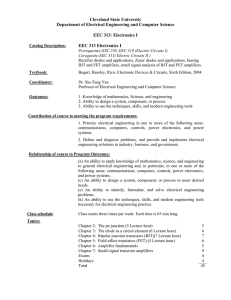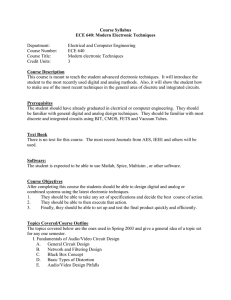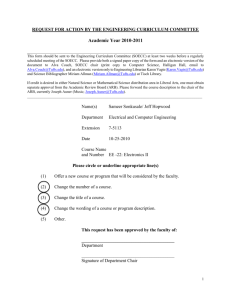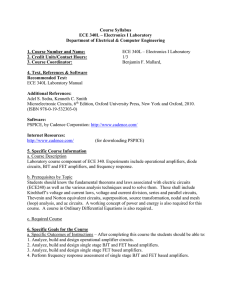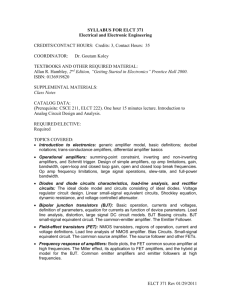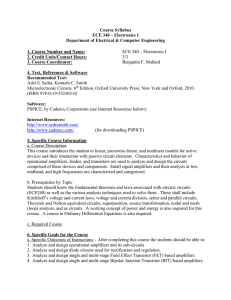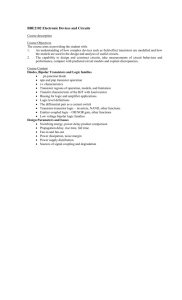Dr. Abdullah A. Almuhaisen
advertisement
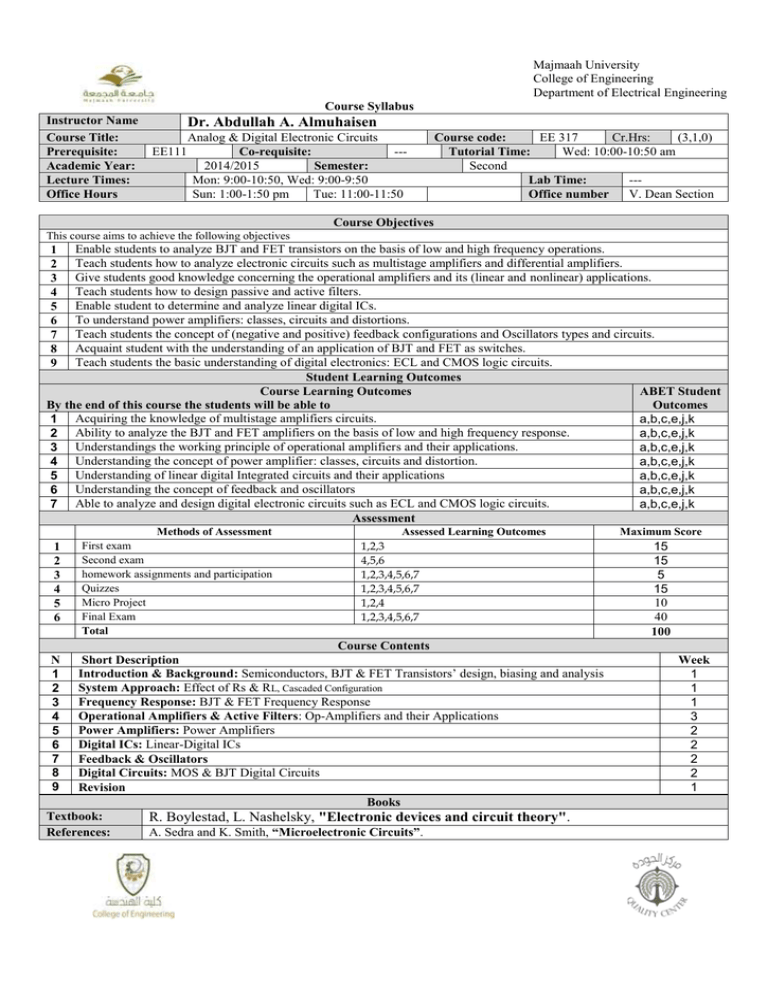
Majmaah University College of Engineering Department of Electrical Engineering Course Syllabus Instructor Name Course Title: Prerequisite: Academic Year: Lecture Times: Office Hours Dr. Abdullah A. Almuhaisen EE111 Analog & Digital Electronic Circuits --Co-requisite: 2014/2015 Semester: Mon: 9:00-10:50, Wed: 9:00-9:50 Sun: 1:00-1:50 pm Tue: 11:00-11:50 EE 317 Cr.Hrs: (3,1,0) Course code: Wed: 10:00-10:50 am Tutorial Time: Second --Lab Time: V. Dean Section Office number Course Objectives This course aims to achieve the following objectives Enable students to analyze BJT and FET transistors on the basis of low and high frequency operations. Teach students how to analyze electronic circuits such as multistage amplifiers and differential amplifiers. Give students good knowledge concerning the operational amplifiers and its (linear and nonlinear) applications. Teach students how to design passive and active filters. Enable student to determine and analyze linear digital ICs. To understand power amplifiers: classes, circuits and distortions. Teach students the concept of (negative and positive) feedback configurations and Oscillators types and circuits. Acquaint student with the understanding of an application of BJT and FET as switches. Teach students the basic understanding of digital electronics: ECL and CMOS logic circuits. Student Learning Outcomes Course Learning Outcomes ABET Student By the end of this course the students will be able to Outcomes 1 Acquiring the knowledge of multistage amplifiers circuits. a,b,c,e,j,k 2 Ability to analyze the BJT and FET amplifiers on the basis of low and high frequency response. a,b,c,e,j,k 3 Understandings the working principle of operational amplifiers and their applications. a,b,c,e,j,k 4 Understanding the concept of power amplifier: classes, circuits and distortion. a,b,c,e,j,k 5 Understanding of linear digital Integrated circuits and their applications a,b,c,e,j,k 6 Understanding the concept of feedback and oscillators a,b,c,e,j,k 7 Able to analyze and design digital electronic circuits such as ECL and CMOS logic circuits. a,b,c,e,j,k Assessment 1 2 3 4 5 6 7 8 9 1 2 3 4 5 6 Methods of Assessment First exam Second exam homework assignments and participation Quizzes Micro Project Final Exam Total Assessed Learning Outcomes 1,2,3 4,5,6 1,2,3,4,5,6,7 1,2,3,4,5,6,7 1,2,4 1,2,3,4,5,6,7 Course Contents Short Description Introduction & Background: Semiconductors, BJT & FET Transistors’ design, biasing and analysis System Approach: Effect of Rs & RL, Cascaded Configuration Frequency Response: BJT & FET Frequency Response Operational Amplifiers & Active Filters: Op-Amplifiers and their Applications Power Amplifiers: Power Amplifiers Digital ICs: Linear-Digital ICs Feedback & Oscillators Digital Circuits: MOS & BJT Digital Circuits Revision Books Textbook: R. Boylestad, L. Nashelsky, "Electronic devices and circuit theory". A. Sedra and K. Smith, “Microelectronic Circuits”. References: N 1 2 3 4 5 6 7 8 9 Maximum Score 15 15 5 15 10 40 100 Week 1 1 1 3 2 2 2 2 1
